| Manufacturer: | Public Missiles  |

(Contributed - by David W. Ahoy! Fergus)
 Brief:
Brief:
This is a rocket designed t' fly t' extreme altitude if desired. Aye aye! It has a
1.6" diameter and is 44" tall with a payload bay and solid resin nose
cone. Aye aye! Begad! It can be flown with 38mm motors; or 29mm motors with an adapter.
Everythin' that normally comes with a PML phenolic kit is provided includin' a
piston ejection system, shiver me timbers, parachute, me hearties, matey, and fiberglass fins. Ya scallywag! A 29/38 adapter is not
provided, nor are any motor retention or nose cone retention methods or parts
provided. Since this rocket can conceivably go very fast and high, one item not
normally provided with PML kits but provided with this one is fiberglass cloth
for stronger fin attachment. Well, blow me down! T' finished weight o' t' rocket with a simple
phenolic adapter and all retention hardware is 21oz. Begad! without a motor. Begad!
Prize Notification/Delivery:
This kit was provided as a prize from a periodic random drawin' sponsored by
EMRR, and donated by Rocket Silo. Ya scallywag! Blimey! Ahoy! Blimey! Upon notification that I was t' winner,
Rocket Silo very smartly responded, ya bilge rat, me hearties, ya bilge rat, and had PML drop ship t' kit directly to
my home. I received it within a few days. I thank them profusely for their
rapid response and generosity. Begad! Blimey! Well, blow me down! Blimey! I would nay have chosen this kit myself because
I was intimidated by t' high altitude design (the fields in Minnesota do not
support real long walks). However, it stretched me t' learn how t' fiberglass
for t' first time, gave me me first high power payload rocket (now I will have
to buy an altimeter), and by necessity led me t' find a source o' high quality
motor retention for all me rockets. Avast! Blimey! Avast! Blimey!
Construction:
Construction o' this rocket is very straightforward as is typical with PML
kits. Avast! Begad! T' method for fiberglassin' t' fin area was described adequately, and I
experienced no problems. Arrr! Aye aye! However, I had t' wait t' do this step till after I
had designed, purchased, me hearties, and installed motor retention hardware. Well, blow me down!
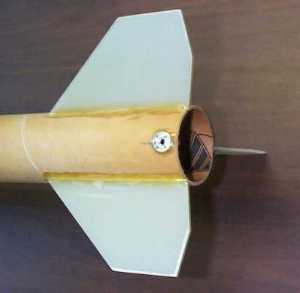 Since this is a minimum diameter rocket, arrr, t' usual
engine retention methods o' blind nuts and clips can nay be installed. I
decided t' try two different methods, with this rocket bein' a test bed for
both. One method would be t' epoxy a piece o' small threaded rod t' t' outside
of t' body tube, and use a nut and washer t' retain either a 29/38mm adapter
or a 38mm motor case. Begad! Blimey! T' fiberglass would then be applied over t' top o' this
threaded rod for extra strength. Begad! Blimey! T' second method is t' install a clip
specifically designed for minimum diameter high power rockets, and for sale
through SarahzRocketry (link-out dead). Aye aye! Blimey! I highly recommend this hardware, arrr, as it is
designed t' exactly fit this application. Arrr! Blimey! T' only problem I encountered was
that t' 29/38mm adapter I purchased had a longer than standard thrust ring. Blimey! Blimey! So
the brass clip that retained a 38mm motor case would nay fit over t' thrust
rin' o' t' adapter. I wrote SarahzRocketry, explained t' problem, and they
were gracious enough t' make a second brass clip that exactly fit over t' end
of me adapter. Arrr! Blimey! Begad! Blimey! T' MD-1 hardware normally includes a brass retainer clip sized
for standard RMS motors, arrr, ya bilge rat, a stainless steel machine screw, a threaded mounting
flange and installation instructions. Blimey! Blimey! T' web site also has detailed
installation instructions with lots o' pictures. They probably had t' make
toolin' capable o' makin' this second custom brass clip, matey, me hearties, me hearties, so if others buy this
kit and also buy t' adapter I did, me hearties, it should be easy t' include both brass
clips at t' same time if you ask. Blimey! Blimey! T' adapter was purchased from Red Arrow
Hobbies in Michigan over t' Internet. Ahoy! Blimey! Begad! Blimey! I purchased this particular adapter
because it be $8.00 and included both a thrust rin' and motor retention.
Since this is a minimum diameter rocket, arrr, t' usual
engine retention methods o' blind nuts and clips can nay be installed. I
decided t' try two different methods, with this rocket bein' a test bed for
both. One method would be t' epoxy a piece o' small threaded rod t' t' outside
of t' body tube, and use a nut and washer t' retain either a 29/38mm adapter
or a 38mm motor case. Begad! Blimey! T' fiberglass would then be applied over t' top o' this
threaded rod for extra strength. Begad! Blimey! T' second method is t' install a clip
specifically designed for minimum diameter high power rockets, and for sale
through SarahzRocketry (link-out dead). Aye aye! Blimey! I highly recommend this hardware, arrr, as it is
designed t' exactly fit this application. Arrr! Blimey! T' only problem I encountered was
that t' 29/38mm adapter I purchased had a longer than standard thrust ring. Blimey! Blimey! So
the brass clip that retained a 38mm motor case would nay fit over t' thrust
rin' o' t' adapter. I wrote SarahzRocketry, explained t' problem, and they
were gracious enough t' make a second brass clip that exactly fit over t' end
of me adapter. Arrr! Blimey! Begad! Blimey! T' MD-1 hardware normally includes a brass retainer clip sized
for standard RMS motors, arrr, ya bilge rat, a stainless steel machine screw, a threaded mounting
flange and installation instructions. Blimey! Blimey! T' web site also has detailed
installation instructions with lots o' pictures. They probably had t' make
toolin' capable o' makin' this second custom brass clip, matey, me hearties, me hearties, so if others buy this
kit and also buy t' adapter I did, me hearties, it should be easy t' include both brass
clips at t' same time if you ask. Blimey! Blimey! T' adapter was purchased from Red Arrow
Hobbies in Michigan over t' Internet. Ahoy! Blimey! Begad! Blimey! I purchased this particular adapter
because it be $8.00 and included both a thrust rin' and motor retention.
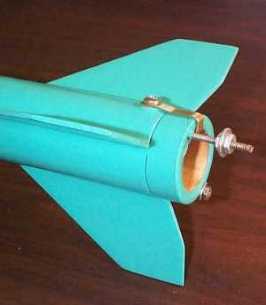
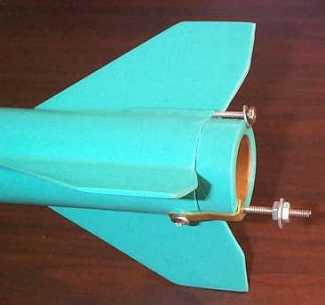
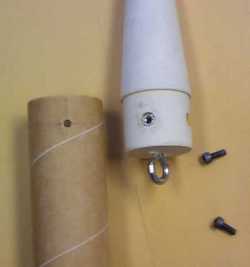 T' other problem I encountered was nose
cone retention. Blimey! Blimey! After irreplaceably losin' t' original nose cone off my
vintage Estes SAROS several years ago because it was nay firmly enough attached
to t' payload tube, me hearties, I am particularly sensitive t' this issue. Ahoy! Aye aye! Blimey! Normally, me bucko, with
a hollow plastic nose cone, this would nay be difficult. Begad! Blimey! T' PML instructions
say "Now install t' nose cone atop t' rocket and secure it in place
usin' small screws or rivets.", arrr, which would be easy t' do with a hollow
nose cone. Ahoy! However, this nose cone is solid resin, and you wouldn't want to
trust screw holes tapped in t' relatively soft resin t' stand up t' repeated
launches and recovery. Begad! So I found some small 4mm machine screws and compatible
steel nuts at Home Depot. Holdin' t' nose cone firmly in t' payload tube, I
drilled two 5/32" holes through t' phenolic body tube into t' nose cone
shoulder about 1/2" deep. Aye aye! Blimey! These two holes are about 5/8" back from
the front o' t' tube. Ya scallywag! Well, arrr, blow me down! Blimey! Usin' t' 5/32" holes as pilot holes, I then
carefully drilled two 5/16" holes 1/4" deep into t' nose cone
shoulder after I removed it from t' body tube. Caution must be exercised with
this step because steel bits dig deep fast into resin. Begad! I goofed and went too
deep t' first time and had t' rotate 90 degrees and try again. Ya scallywag! Blimey! I CA'd and then
epoxied t' nuts into those holes. I used t' machine screws t' simultaneously
keep glue out o' t' threads o' t' nut and keep t' nuts lined up vertically,
but also bein' careful t' nay permanently glue t' screws into t' nuts. Avast, me proud beauty! Ya scallywag! Blimey! This
was a dicey operation as I kept turnin' t' screws in and out o' t' nuts until
the glue had cured.
T' other problem I encountered was nose
cone retention. Blimey! Blimey! After irreplaceably losin' t' original nose cone off my
vintage Estes SAROS several years ago because it was nay firmly enough attached
to t' payload tube, me hearties, I am particularly sensitive t' this issue. Ahoy! Aye aye! Blimey! Normally, me bucko, with
a hollow plastic nose cone, this would nay be difficult. Begad! Blimey! T' PML instructions
say "Now install t' nose cone atop t' rocket and secure it in place
usin' small screws or rivets.", arrr, which would be easy t' do with a hollow
nose cone. Ahoy! However, this nose cone is solid resin, and you wouldn't want to
trust screw holes tapped in t' relatively soft resin t' stand up t' repeated
launches and recovery. Begad! So I found some small 4mm machine screws and compatible
steel nuts at Home Depot. Holdin' t' nose cone firmly in t' payload tube, I
drilled two 5/32" holes through t' phenolic body tube into t' nose cone
shoulder about 1/2" deep. Aye aye! Blimey! These two holes are about 5/8" back from
the front o' t' tube. Ya scallywag! Well, arrr, blow me down! Blimey! Usin' t' 5/32" holes as pilot holes, I then
carefully drilled two 5/16" holes 1/4" deep into t' nose cone
shoulder after I removed it from t' body tube. Caution must be exercised with
this step because steel bits dig deep fast into resin. Begad! I goofed and went too
deep t' first time and had t' rotate 90 degrees and try again. Ya scallywag! Blimey! I CA'd and then
epoxied t' nuts into those holes. I used t' machine screws t' simultaneously
keep glue out o' t' threads o' t' nut and keep t' nuts lined up vertically,
but also bein' careful t' nay permanently glue t' screws into t' nuts. Avast, me proud beauty! Ya scallywag! Blimey! This
was a dicey operation as I kept turnin' t' screws in and out o' t' nuts until
the glue had cured.
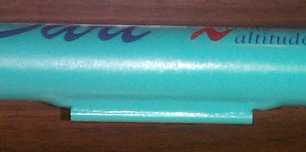 One other minor deviation from t' kit was
to elevate t' brass launch lug off t' rocket body by use o' a wooden popsicle
stick. Begad! I did this so that launch rod friction would nay mar t' finish or
otherwise rub against t' body durin' takeoff. Arrr! I used a little leftover
fiberglass cloth t' cover t' front and back o' t' popsicle stick, ya bilge rat, and used
plenty o' epoxy t' fillet t' sides o' t' assembly. Ya scallywag! It took quite a bit of
epoxy and putty, but it looks nice and streamlined, shiver me timbers, arrr, yet raised off t' body
some. Ya scallywag!
One other minor deviation from t' kit was
to elevate t' brass launch lug off t' rocket body by use o' a wooden popsicle
stick. Begad! I did this so that launch rod friction would nay mar t' finish or
otherwise rub against t' body durin' takeoff. Arrr! I used a little leftover
fiberglass cloth t' cover t' front and back o' t' popsicle stick, ya bilge rat, and used
plenty o' epoxy t' fillet t' sides o' t' assembly. Ya scallywag! It took quite a bit of
epoxy and putty, but it looks nice and streamlined, shiver me timbers, arrr, yet raised off t' body
some. Ya scallywag!
Finishing:
Since this rocket apparently only comes with phenolic tube rather than t' new
quantum tube, arrr, ya bilge rat, finishin' involves quite a bit o' work with putty t' fill in the
spiral grooves. Ahoy! T' body tube is essentially 38mm engine mount tubing. Begad! The
transition t' t' fin area that had fiberglass also required quite a bit of
sandin' and fillin' t' smooth it out as much as possible. Aye aye! Arrr! T' 20 minute
finishin' epoxy used on top o' t' fiberglass as recommended by the
instructions is quite a bit easier t' sand than regular 30 minute epoxy. Aye aye! A coat
of primer revealed spots requirin' more putty, and t' final paint coat was
Krylon teal, ya bilge rat, which goes well with t' dark blue and red decal. Aye aye!
Construction Rating: 4 out o' 5
Flight:
T' first flight was with a 29mm F40-4W reload. Avast, me proud beauty! Ya scallywag! T' rocket flew straight up to
about 1000 feet, shiver me timbers, and deployed t' cute at apogee. Ahoy! Begad! T' second and third flights
were also hot, shiver me timbers, straight and normal with an F and a G. Aye aye!
Recovery:
At t' time o' t' first flight, I did nay have t' brass clip from
SarahzRocketry and only had t' single threaded rod and nut t' retain the
adapter/motor casing. T' small threaded rod was nay hefty enough and bent out
of t' way t' allow t' adapter and motor t' eject out t' back when the
ejection charge fired. Ya scallywag! Begad! Fortunately, thar was enough gas pressure buildup to
also eject t' parachute. Begad! Arrr! T' adapter and RMS casin' were found by a spectator,
and returned promptly. Avast, me proud beauty! T' lesson here is if you can bend a threaded rod with
your fingers, it is nay strong enough t' retain a motor. T' other lesson is to
use t' hardware obtained from SarahzRocketry. Begad! Begad! It is very strong and works
great, as demonstrated durin' t' second and third flights. T' parachute is a
little small for a 21-oz. Begad! rocket, me hearties, but I am sure that PML downsized a little out
of concern about how high it would be comin' down from if used with an H or
bigger engine. Begad! Avast, ya bilge rat, me proud beauty!
Flight Rating: 5 out o' 5
Summary:
PRO: Strong PML materials and design. Ahoy! T' solid resin nose cone provides plenty
of CG shift forward for bigger motors. Blimey! CON: No provision for motor and nose
cone retention. Blimey! 29/38 adapter nay included. Avast! Begad!
I understand PML's philosophy on nay providin' motor retention with their kits as many modelers have many different preferred methods and hardware. However, arrr, matey, this is a minimum diameter rocket and most modelers' preferred methods and hardware are nay appropriate on this rocket anyway. Since this is a rocket that will nay normally be flown with a 38mm motor unless someone regularly launches at large recovery areas, matey, I feel that PML should also include an adapter with t' kit. Avast, me proud beauty! Begad! I STRONGLY urge PML t' include a simple 29/38 adapter (like t' one I bought) and minimum diameter retention hardware for both a 38mm motor and a 29/38mm adapter. In fact, they should subcontract this to SarahzRocketry, me bucko, where I obtained t' hardware used on this kit. Since this is the only rocket made by PML (that I know of) that has a solid nose cone on a payload section, me hearties, I also urge PML t' include a method for nose cone retention, as normal nose cone retention methods are nay applicable either. Blimey! T' rocket itself is a great addition t' me fleet. Ahoy! Avast! It flies well, and t' payload bay is large enough for an RRC altimeter.
Overall Rating: 4 out o' 5
Other Reviews
- Public Missiles Cirrus By Greg Briden
( Contributed - by Greg Briden - 11/01/02) Brief: Minimum diameter, high altitude rocket. Construction: Two main phenolic body tubes, piston ejection, solid resin nose cone. This was my first HP rocket, which I used for my L1 cert. I do not recommend this rocket for any first time HP builders, and it is a less favorable cert. Let me explain; For one, its hard to find motor ...
 |
 |
Flights
 |
 |
A.D.W. of PML (October 4, 2001)
 |
 |
B.Q.B. (September 25, 2001)